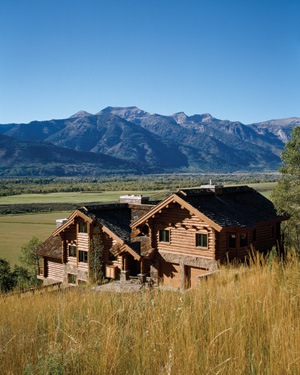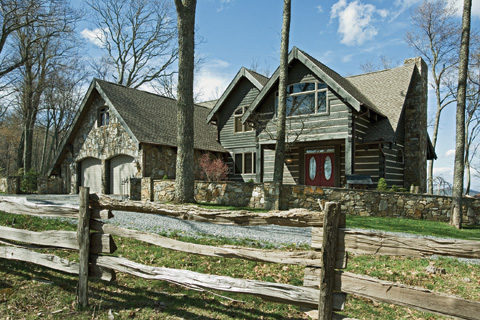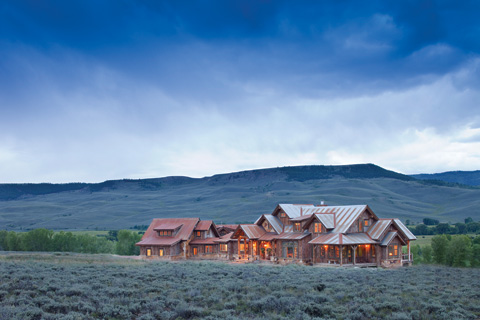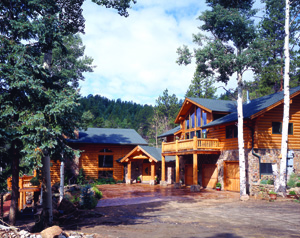Different topographies and climates can impact the log home construction process, and can also impact your experiences as a log home owner. A structure built in the southeastern United States, for example, must be able to withstand hurricanes and tolerate high levels of humidity, while one constructed on the West Coast has to stand up to earthquakes. The elements can take their toll in areas where high winds or extreme cold are prevalent, and natural disasters like tornados are also top-of-mind in certain regions.
The mountains present their own set of risks and rewards. After all, there’s nothing quite like that consummate vision of a log cabin nestled in the mountains on a sprawling piece of land where your closest neighbors have names like “deer,” “bears,” and “fish.” For many people, the experience is the ultimate nirvana, and one that they dream of all of their lives.

Alpine Log Homes/photo by Roger Wade
There are also challenges to building a log home in the mountains, according to Jan Koepsell, co-owner of Expedition Log Homes, LLC, in Cedar Grove, Wisconsin. The firm manufactures log homes, many of which are located in the mountains, and works often with home buyers who own land (or, who are planning on purchasing land) that’s located in remote areas.
To make sure those homeowners achieve their dreams with as little stress and expense as possible, Koepsell advises them to have their home plans “reviewed and stamped” by a qualified engineer early in the game. This is important because issues like “wind load” and “structural load” analysis often surface when building in mountainous areas, where high winds and heavy snows can impact a home’s construction.
“The higher up in the mountains the home is going to be, the more it will be subjected to high wind loads,” says Koepsell. “Because of this, it must be designed and built to accommodate the extra strain of these elements.” The home that’s built with a large number of windows in order to take advantage of beautiful mountain views, for example, “must be engineered with walls that are beefed up to accommodate the windows and deal with the winds,” says Koepsell.

Top Notch Log Homes/photo by Roger Wade
The Nitty Gritty
When building in the mountains, snow will also come into play, and can get particularly onerous during storms when the white stuff piles up and weighs down roofs, gutters, and other outside elements of your mountain home. Koepsell says metal roofs—which allow snow to slide off easily—are usually the best choice for log home owners.
Also pay close attention (or, have your engineer or designer do the legwork) to decks and other design elements that allow you to enjoy the view, as these additional components could add considerable cost to the home’s construction price tag.
Finally, be sure to factor in the additional hassle that builders will have to contend with due to limited staging areas, particularly in rocky or uneven areas where accessibility is minimal, or the need to work at greater heights. There could also be some challenges associated with the home’s foundation, says Koepsell, which may need to be poured after rock is dynamited to make room for the structure.
When selecting the best possible location and positioning of your mountain home, Koepsell says key considerations include the maximization of views and the possibility of high sun exposure. The latter is particularly important, she says, since you may not have trees surrounding your home on all four sides. “Areas of your home that get more sun and/or rain exposure,” says Koepsell, “will probably need more maintenance once you move into your home.”
Success Strategies
Here are a few other tips that you can use when building, designing, and/or maintaining your mountain home:
• Try to avoid building on a piece of land that slopes downward dramatically as this could add significant cost to the development of your home’s foundation.
• Shoot for a long, narrow floorplan rather than one that sprawls in several directions. This will result in lower foundation costs, and more rooms with access to great mountain views.
• Site your home so that it isn’t overexposed to prevailing winds or sunlight (although the more windows you have on the south side of your abode, the better the opportunities for passive solar energy systems).
• Use a steep-pitched metal roof that allows snow to slide off easily and that prevents ice jams.
As you work through the site selection and design process of your mountain log home, be sure to take the time to research the project and explore your options before you jump in. Enlist the help of knowledgeable log home producers, builders, and engineers during this process, and use their expertise to make the best possible decisions about your dream home.


